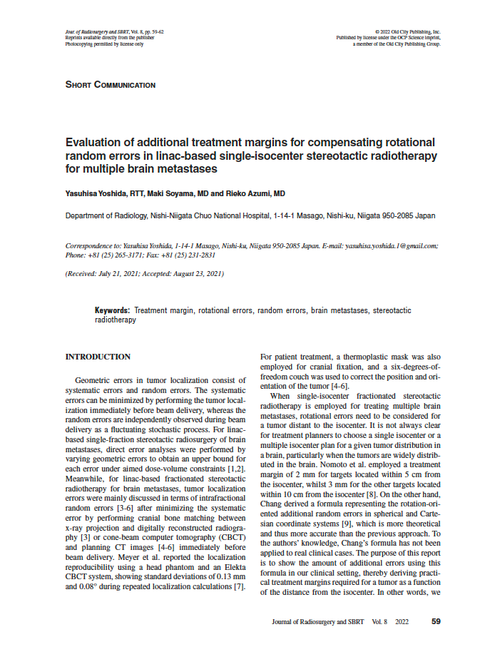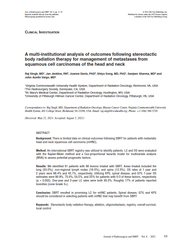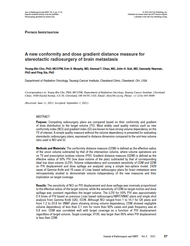- Home
- Journal Contents Downloads
- JRSBRT Downloads
- JRSBRT 8.1, p. 59-62
Product Description
Evaluation of additional treatment margins for compensating rotational random errors in linac-based single-isocenter stereotactic radiotherapy for multiple brain metastases
Yasuhisa Yoshida, Maki Soyama and Rieko Azumi
Geometric errors in tumor localization consist of systematic errors and random errors. The systematic errors can be minimized by performing the tumor localization immediately before beam delivery, whereas the random errors are independently observed during beam delivery as a fluctuating stochastic process. For linac-based single-fraction stereotactic radiosurgery of brain metastases, direct error analyses were performed by varying geometric errors to obtain an upper bound for each error under aimed dose-volume constraints [1,2]. Meanwhile, for linac-based fractionated stereotactic radiotherapy for brain metastases, tumor localization errors were mainly discussed in terms of intrafractional random errors [3-6] after minimizing the systematic error by performing cranial bone matching between x-ray projection and digitally reconstructed radiography [3] or cone-beam computer tomography (CBCT) and planning CT images [4-6] immediately before beam delivery. Meyer et al. reported the localization reproducibility using a head phantom and an Elekta CBCT system, showing standard deviations of 0.13 mm and 0.08° during repeated localization calculations [7]. For patient treatment, a thermoplastic mask was also employed for cranial fixation, and a six-degrees-of-freedom couch was used to correct the position and orientation of the tumor [4-6].
When single-isocenter fractionated stereotactic radiotherapy is employed for treating multiple brain metastases, rotational errors need to be considered for a tumor distant to the isocenter. It is not always clear for treatment planners to choose a single isocenter or a multiple isocenter plan for a given tumor distribution in a brain, particularly when the tumors are widely distributed in the brain. Nomoto et al. employed a treatment margin of 2 mm for targets located within 5 cm from the isocenter, whilst 3 mm for the other targets located within 10 cm from the isocenter [8]. On the other hand, Chang derived a formula representing the rotation-oriented additional random errors in spherical and Cartesian coordinate systems [9], which is more theoretical and thus more accurate than the previous approach. To the authors’ knowledge, Chang’s formula has not been applied to real clinical cases. The purpose of this report is to show the amount of additional errors using this formula in our clinical setting, thereby deriving practical treatment margins required for a tumor as a function of the distance from the isocenter. In other words, we can determine the maximum length from the most distant tumor to the isocenter for a single isocenter treatment under a given margin. Treatment margins and the confidence level of dose delivery are also discussed when the additional errors are not considered.
Keywords: Treatment margin, rotational errors, random errors, brain metastases, stereotactic radiotherapy
After payment has been processed for your order of a digital copy (PDF) of this article, you will see a download link on your completed order page and also receive an email containing a download link. The links, which will enable you to download one copy of the article, will expire after 24 hours.
 Loading... Please wait...
Loading... Please wait...








